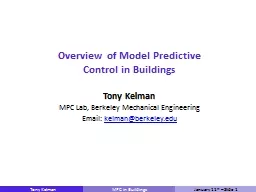

Control in Buildings Tony Kelman MPC Lab Berkeley Mechanical Engineering Email kelmanberkeleyedu TexPoint fonts used in EMF Read the TexPoint manual before you delete this box A ID: 675650
Download Presentation The PPT/PDF document "Overview of Model Predictive" is the property of its rightful owner. Permission is granted to download and print the materials on this web site for personal, non-commercial use only, and to display it on your personal computer provided you do not modify the materials and that you retain all copyright notices contained in the materials. By downloading content from our website, you accept the terms of this agreement.
Slide1
Overview of Model PredictiveControl in Buildings
Tony KelmanMPC Lab, Berkeley Mechanical EngineeringEmail: kelman@berkeley.edu
TexPoint fonts used in EMF.
Read the TexPoint manual before you delete this box.:
A
A
A
A
A
A
A
A
A
A
A
A
A
A
A
A
A
A
A
ASlide2
Outline
Model predictive
control
Basic idea and elements
Advantages, disadvantages
Modeling
and
MPC in
buildings
What works, what doesn’t
Generating models using historical data
Advanced control behavior
Experimental
projects
Success stories
Increased scope and capabilities over timeSlide3
System model – state evolution
vs
inputs and disturbances
Constraints on inputs or states – requirements, actuator limitsCost function – reference tracking, energy, comfortForecast trajectories of future disturbance inputs – weather, occupancy, utility ratesOptimization algorithm – fast enough to solve in real time
Use predictive knowledge for controlBasic componentsSystem modelConstraints on inputs or statesCost functionForecast trajectories of future disturbance inputsOptimization algorithmAdvantages: multivariable, model based, nonlinear, constraint satisfaction, incorporates predictionsDisadvantages: computational complexity, design effort of accurate modeling
Model Predictive ControlSlide4
Model Predictive Control
Initialize with current measurements at time tPredict response over horizon of p stepsSolve for best input sequence, apply first element u*(t)Repeat at time t+1 with new measurements (feedback)Slide5
Optimization Formulation
Predicted states
x
k
, inputs
uk, disturbances wkAt each time step, solve:Constrained finite time optimal control problemOptimization much faster if explicit structure of J, f, g (and derivatives) can be providedSlide6
Outline
Model predictive control
Basic idea and elements
Advantages, disadvantages
Modeling and MPC in buildings
What works, what doesn’tGenerating models using historical dataAdvanced control behaviorExperimental projectsSuccess storiesIncreased scope and capabilities over timeSlide7
Modeling for Building Energy Systems
Common practice is black-box simulation
DOE2,
EnergyPlus
, TRNSYS,
etcUseful for design, very difficult to use for controlDerivative-free optimization not very efficient or scalableNeed model structure for optimization and controlSimpler approach: reduced order modelingPhysics based model structureData driven parameter identificationCan adjust accuracy vs complexity tradeoff
Large scale real time optimization tractableSlide8
HVAC good target for energy savings by better control
Common configuration for commercial buildings:
VAV with reheat
Control inputs: supply fan, cooling coil, heating coils, zone dampers, air handling unit dampers
States: zone temperatures
HVAC Example SystemSlide9
Thermal Zone ModelSlide10
Network of bilinear systemsA(simple extension to multiple statesper zone, RC network analog)Simplest Useful Model Abstraction
Thermal zone model
Static nonlinearities
Equipment performance maps (chillers, cooling towers, pumps, fans, coils)
Equality and inequality constraints
Comfort range
Dynamic coupling: thermal zones, supply air & return air
Uncertain
load predictions
Human:
occupancy, thermal comfort, …
Environment
: ambient temperature, solar
radiation
, …Slide11
How to Generate Reduced Models
Several options to create model data
Direct physics based lumped parameters
Model reduction from high fidelity design tools
Use historical data for model identification
Identification results vs measured data, Bancroft librarySlide12
Using Data to Quantify Uncertainty
Ambient temperature
Load
SMPC
Prediction model
Historical load
realizationSlide13
Advanced Control Behavior
MPC is able to incorporate time-varying energy price and reduce peak power consumption
Time-varying price
Penalize peak power
A.
Kelman
, Y. Ma, A. Daly, F.
Borrelli
,
Predictive Control for Energy Efficient Buildings with Thermal Storage: Modeling, Stimulation, and Experiments,
IEEE Control System Magazine
, 32(1), page 44-64, February 2012.Slide14
Outline
Model predictive control
Basic idea and elements
Advantages, disadvantages
Modeling and MPC in buildings
What works, what doesn’tGenerating models using historical dataAdvanced control behaviorExperimental projectsSuccess storiesIncreased scope and capabilities over timeSlide15
UC Merced –, Merced, CA
4% Improvement LBNL+UTRC- Storage, Chiller Optimization Horizon 24hrs, Sampling 30min Problem Size: ~300 variables , ~1440 constraintsCERL Engineering Research Laboratory, Champaign, IL
15% improvement.
UTRC-
HVAC distribution – 5 zones Horizon 4hrs, Sampling 20 min, Problem Size: ~1600 variables , ~1400 constraintsNaval Station Great Lakes, North Chicago, Illinois UTRC- Conversion + Storage – 250 zones Problem Size: ~~20k variables , ~?? constraintsCITRIS Building (UC Berkeley) – Major issues Siemens - Generation + HVAC distribution -135 Zones Horizon 4hrs, Sampling 20 min, Problem Size: ~~10k variables , ~?? constraints
Brower Center (Slab Radiant), Berkeley, CA Architecture Department Models based on step tests experimentsWhite Oak, Silver Spring, MD
Honeywell
Microgrid
Optimization
Experimental Projects
Simplified models and BLOM tool critical
for real-time implementation of large MPC experimentsSlide16
Distributed ImplementationSlide17
Distributed Implementation
Supply FanCooling coil
damper
Heating coil
VAV damper
Zone temperatureCoordinatorDual variables